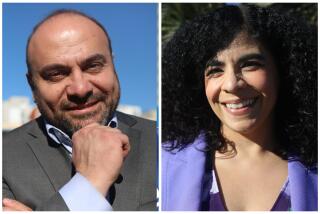First & Spring: Biking and walking likely to be major issues in spring city elections
- Share via
On a quiet Sunday morning in East L.A. a few weeks back, the campaign between Los Angeles City Councilman Jose Huizar and County Supervisor Gloria Molina provided its first truly awkward moment.
Huizar, who is seeking a third term in the March 3 council election, was onstage for the latest CicLAvia, the popular event where major boulevards are closed to everyone but bicyclists and pedestrians. A couple feet away was Molina, who recently jolted the Eastside by announcing her plan to unseat Huizar. The only person standing between them was Mayor Eric Garcetti, who has mostly avoided discussing the showdown.
The scene provided fresh evidence that biking and walking have become potent political issues in L.A., where activists are pushing for more bike lanes, sidewalk improvements and other measures aimed at reducing the city’s reliance on the car.
The campaign for Huizar’s seat could demonstrate just how influential the emerging voting bloc of bicyclists, pedestrian advocates and planning wonks really is. When Molina announced her City Council bid two months ago, some of those activists quickly rose to Huizar’s defense.
“He has worked harder than anybody else on the council to make streets for people, not just the movement of cars,” said Josef Bray-Ali, owner of Flying Pigeon LA bike shop. “If the bike and the walking advocates and the livable streets advocates can’t get behind Jose Huizar, we are a worthless constituency.”
Bray-Ali has offered to walk door to door for Huizar and stage events on his behalf. What’s driving that support can be seen on the streets of Huizar’s downtown-to-Eagle Rock district.
Over the last decade, the city has put about 50 miles of streets on “road diets,” restriping them to subtract car lanes and make more room for bikes or pedestrians. Huizar’s district leads the pack with 17 miles, nearly twice the total in any other district.
He’s pursued other improvements welcomed by cyclists and walkers, including butterfly-shaped bike racks in Boyle Heights and outdoor seating, umbrellas and oversized planters on Broadway, which lost a car lane on a 1-mile stretch through downtown this year.
Huizar supporter Nathan Lucero recalled a pivotal moment last year, during a community meeting over a plan to add bike lanes and subtract car lanes from Colorado Boulevard in Eagle Rock. At the end of the contentious meeting, Huizar stood up and announced his support for the idea.
“It took a lot of guts for a councilman to go up in front of a lot of people who are opposed to the idea and say he was going to implement it anyway,” said Lucero, who bikes to work two to three days per week.
Huizar’s clout with cyclists could be seen last month, when he was invited to address the Los Angeles County Bicycle Coalition’s first annual gala. If he is reelected, Huizar plans to consider more road diets in his district, including along Soto Street in Boyle Heights, according to spokesman Rick Coca.
But he is also facing pushback from critics such as John Nese, owner of Galco’s Soda Pop Stop, which sells carbonated beverages and beers in his district. Nese, who is considering supporting Molina, cited a road diet imposed on York Boulevard in Highland Park. That initiative is causing traffic backups, he said.
“It’s diverting traffic onto side streets and creating problems in the neighborhood,” Nese said.
Indeed, L.A.’s bike politics can prove treacherous. Councilman Gil Cedillo has been embroiled in a nasty feud with activists, including Bray-Ali, who are furious that he halted a road diet in his district. In the recent race to replace County Supervisor Zev Yaroslavsky, bike lane advocates accused former state Sen. Sheila Kuehl of taking a pro-car, “windshield” approach to the issue.
Huizar declined interview requests. But Coca said the reworked roadways benefit the entire community, not any particular interest group. For example, the Colorado Boulevard makeover includes other improvements, he said, such as flashing crosswalks, speed signs and later hours for businesses.
“It wasn’t just bike lanes,” Coca said. “It was … a more comprehensive approach.”
Molina, for her part, said she won’t be an “absolute yes or an absolute no” for any group, including bicycle and pedestrian advocates. But she also stressed her own record of improving bike paths, and the areas around them, along the Los Angeles, San Gabriel and Rio Hondo rivers.
A 32-year political veteran, Molina secured more than $500,000 to extend CicLAvia into East L.A. She recently found money to install bike racks and showers for those who cycle to work at the East L.A. Civic Center. And on Friday, she announced plans for a jogging path and other improvements near Calvary Cemetery in East L.A.
“While I might not have a road diet agenda on my plate right now, my involvement in pedestrian and bike access started long before I decided to jump into the campaign,” she said.
For now, the L.A. activists seeking more walking and biking improvements don’t have a political action committee, or much of anything else that would make them competitive with business groups or organized labor. But they’ve been dipping their toes in the water, sending questionnaires to candidates and posting endorsements on Twitter and Facebook.
Eric Bruins, who handles policy for the Bicycle Coalition, said he hoped to shift the debate in the upcoming election, so that candidates talk about ways to make it easier for Angelenos to get where they want without having to drive.
“In L.A., we always talk about traffic as an election issue,” he said. “I’d like to see ‘great streets’ become an election issue, where candidates are prioritizing livability over the movement of cars.”
Times staff writer Doug Smith contributed to this analysis.
More to Read
Sign up for Essential California
The most important California stories and recommendations in your inbox every morning.
You may occasionally receive promotional content from the Los Angeles Times.











